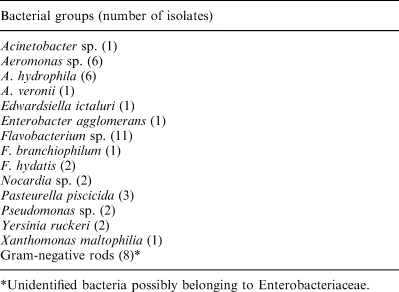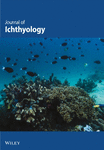Health status of rudd (Scardinius erythrophthalmus hesperidicus H.) in Lake Vrana on the Island of Cres, Croatia
Abstract
The health status of rudd (Scardinius erythrophthalmus hesperidicus H.) in Lake Vrana, the largest Croatian karstic lake, was evaluated. Studies comprising parasitological, haematological and bacteriological surveys were conducted over a 2-year period. Parasitological examination revealed a light infestation of 27% of the examined fish, mostly Dactylogyrus and Ichthyophthirius species. Haematological studies showed that haematocrit values were lower than the physiological limit. A haematocrit coefficient of correlation in all research periods was higher than 15%, indicating that the majority of fish in the study were susceptible to the development of bacterial and other diseases. Indeed, a diverse array of bacteria were isolated from rudd, mainly Flavobacterium spp. and Aeromonas spp., but also some specific fish pathogens, notably Pasteurella piscicida, Yersinia ruckeri, and Edwardsiella ictaluri, were identified. Under stress conditions, detected bacterial species can give rise to disease outbreaks.
Introduction
Lake Vrana is the largest lake of the Adriatic islands. Situated in the midst of the Croatian Island of Cres, it has a surface area of 5.7 km2, a volume of 2.2 × 108 m3, and a maximum depth of 78 m (Teskeredzić et al. 1990). It is a natural phenomenon of fresh water amidst the karstic rocks unique to the Mediterranean area. The lake is monomictic and strongly stratified from springtime until the end of winter, when it becomes completely homothermic (Ridanović and Orešić 1996). Lake Vrana is the largest cryptodepression in Croatia, and a permanent lake in carbonate rocks. Because the lake is the only freshwater body for the islands of Cres and nearby Lošinj, it has a critical importance as a source of drinking water for the local population (Tomec et al. 1996).
Rudd (Scardinius erythrophthalmus hesperidicus H.) is the dominant species among the (only) four fish species living in the lake: rudd (S. erythrophthalmus hesperidicus H.), tench (Tinca tinca L.), chub (Leuciscus cephalus albus B.), and pike (Esox lucius L.).
According to Maitland (1977), rudd are found in lakes and slow-flowing rivers throughout much of Europe. Usually up to 45 cm in length, they have large silvery scales and bright red lower fins. Rudd spawn in May–June, in shoals among weeds. The adults mature after 2–3 years. Rudd feed on invertebrates and aquatic vegetation. They are of little commercial value, but serve as a sport and a bait species in some countries.
In a survey conducted on the lake during 1989 and 1990, Teskeredžić et al. (1990) found neither bacterial diseases notifiable to the OIE (World Organisation for Animal Health) nor other significant diseases. Also, haematological parameters and necropsy results indicated a healthy population. During our investigations, a re-evaluation of the health status of fish living in the lake, namely rudd, was carried out.
Materials and methods
Studies were conducted during a 2-year period, from November 1995 to November 1997. Rudd were netted from three locations in the lake; a total of 230 specimens were examined.
A parasitological examination of wet mount preparations was performed.
Blood was sampled without anaesthesia from the caudal artery. Haematocrit was determined by the microhaematocrit method (Wedemeyer and Yasutake 1977). The percentage of packed cells to total volume was determined by direct measurement. Total proteins were measured using a hand-held refractometer (Atago, Tokyo, Japan). After withdrawal of blood, the fish were sacrificed.
Gross clinical signs of disease and internal abnormalities apparent during postmortem examination were noted.
For bacteriological examination, samples of gills, liver, kidney and spleen were streaked onto tryptic soy agar (TSA; Biolife Milan, Italy). The plates were incubated at 22 °C for 48–72 h. Representative colonies of the different morphological bacterial types were isolated and restreaked in fresh medium until purity was attained. Pure cultures of the isolated bacteria were subjected to morphological, physiological and biochemical tests. The taxonomic position of the isolates was determined by following the schemes of Austin and Austin (1987) and Bergey’s (1984) manual of systematic bacteriology. Also, API 20E and API 20NE systems (Biomerieux, Marcy-L’Etoile, France) were applied. For the detection of Pasteurella piscicida, we also used the rapid agglutination test Mono Pp (Bionor, Skien, Norway).
Mean values and standard deviations were calculated and the results of the analyses were processed using standard statistical methods.
Results
The examined specimens were comprised of 80 males 25.6 ± 6.9 cm mean standard length, 465.4 ± 271.1 g mean weight, and 150 females 24.3 ± 5.3 cm mean standard length, 397.7 ± 183.5 g mean weight.
Of all the fish under study, 27% carried a parasite, but almost never as an excessive load. In February 1996 and August 1997, no parasites were detected. In the remainder of the research period, Dactylogyrus spp. were regularly observed (39% of all parasite infestations). Ichthyophthirius spp. were predominant in May 1996. Occasionally, Trichodina spp. (in winter months) and Gyrodactylus spp. (mostly in the springtime) were found.
Haematological studies showed that males had higher haematocrit values than females. The mean haematocrit values of rudd males were 31.43 ± 7.69%, females 30.65 ± 5.12%. A correlation (r = 0.54) between individual haematocrit level and fish body weight was found. A haematocrit coefficient of variation in all research periods was high, up to 26% in May 1996. Of all the seasons, mean haematocrit values were the lowest in August 1996 (27%). There was a strong negative correlation (r = −0.94) between total plasma protein concentration and water temperature. Plasma protein levels were relatively high in winter months, with mean values ranging between 5.2 and 5.9 g/100 ml.
The results obtained from bacteriological examinations indicated that rudd in Lake Vrana had relatively low levels of infection (21%). Bacteria were isolated in all research periods except in May 1996 when no bacterial infection was detected. A considerable diversity was found among isolated bacterial species (Table 1). The predominant groups were Flavobacterium and Aeromonas bacteria, comprising more than 50% of the isolates. Other bacterial taxa appeared in low percentages, although among them were some aetiological agents of fish diseases (Edwardsiella ictaluri, Pasteurella piscicida, Yersinia ruckeri). Almost 17% of the isolated bacteria were unidentified Gram-negative rods of fermentative metabolism, which produced catalase but not oxidase, most likely belonging to Enterobacteriaceae. Bacterial species of the genus Flavobacterium were predominant in November and February. Representatives of the Aeromonas group were also most frequently recovered in winter months. Most of the unidentified Gram-negative bacteria were also isolated in February.
In 34% of the fish under study, necropsy showed signs of disease, but there was not always a link between isolated bacteria and postmortem findings on respective specimens. From 9.5% of the fish under evaluation, bacteria were isolated but the fish manifested no obvious signs of disease.
Discussion
The parasite infestations of examined rudd were not extensive, and no fish morbidity could be attributed to the parasite load. Also, none of the parasites with zoonotic potential was detected. It is unlikely that any of the diagnosed parasites could cause pathological changes on rudd under normal conditions in the lake.
The study revealed that haematocrit values vary with respect to sex, also noted by Goede and Barton (1990), and increase with body weight, as demonstrated by Alhassan et al. (1993). A haematocrit coefficient of variation during all research periods was higher than 15%, which indicates that the majority of rudd under evaluation was prone to development of bacterial and other diseases, or already unhealthy (Goede and Barton 1990). In most cases, haematocrit values were lower than the physiological limit (32%), which occurs during most bacterial diseases. Haematocrit and plasma proteins also seemed to be affected by water temperature, showing the lowest values in summer months, which possibly could have been triggered by oxygen stress. A diverse array of bacteria were isolated from the organs of rudd, but Flavobacteria and Aeromonas were the predominant groups. A similar situation, to some extent, was detected on wild fish in north Portugal (Sousa et al. 1996). In the same paper, the authors observed that 20% of wild fish were infected, which corresponds to our findings of 21%.
All of the studied Aeromonas isolates were motile. Motile aeromonads occur widely in water and sewage, and have been isolated occasionally from apparently healthy people (Bergey 1984). Aeromonas hydrophila has been recognized as a pathogen in a wide variety of freshwater fish, but is generally considered a secondary invader of already compromised hosts (Austin and Austin 1987). Sugita et al. (1995) strongly suggested that aeromonads are indigenous in fish intestines, water and sediments, and have the potential to be predominant in aquatic environments. Flavobacteria also occur naturally in an aquatic environment. The majority of rudd from which flavobacteria were recovered had autopsy findings ranging from haemorrhaging in the air bladder, pale spleen, focal discolorations of liver and kidney to a swollen intestine containing fluid. Although flavobacteria mostly cause gill diseases, they can also lead to systemic infections (Austin and Austin 1987).
Pasteurella piscicida was isolated from three fish during the summer months. All three fish had a few pathological signs, including pathognomonic granulomatous-like deposits on the liver and spleen.
As swimming in as well as living around the lake are forbidden, the amount of organic pollution in the lake is low. However, there was a relatively high abundance of enterobacteria recovered from the fish. Isolated twice was Yersinia ruckeri, thought to be a normal inhabitant of the digestive tract of fish and ever-present in contaminated waters (Romalde et al. 1994). Both fish from which Y. ruckeri was recovered had nodules on the liver, and one fish also had ascitic fluid in the abdominal cavity, but neither had specific symptoms of the redmouth disease. According to Austin and Austin (1987), unstressed carrier fish do not transmit Y. ruckeri to recipient fish, but under stress conditions, colonization of the lower intestine does take place in the recipient fish. Outbreaks generally occur only after the fish have been exposed to large numbers of the pathogen. The presence of asymptomatic carriers is of potential epidemiological importance because of the persistence of these pathogens in the environment (Sousa et al. 1996). Although Edwardsiella ictaluri was detected only once, it is a noteworthy finding, as the bacillus, a causative agent of enteric septicaemia of catfish, is listed as of current or potential international significance in aquaculture (OIE 1997).
Some, if not all, bacterial species detected in the study can give rise to disease outbreaks under stress conditions. The most important natural environmental factors that stress fish are temperature, dissolved oxygen concentration, predation and food availability (Heath 1990). During certain periods of the year fish may be naturally stressed to such a degree that the addition of another stressor will cause their physiological limits to be exceeded.
Our studies indicate imperilled health of some rudd examined. To prevent the outbreak of diseases, the ecological balance in the lake should be maintained and the possibilities of acute and chronic stress for fish in the lake should be brought to a minimum.





